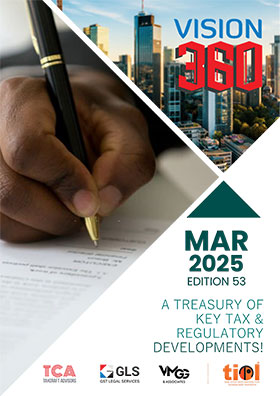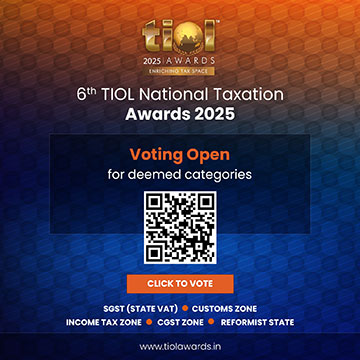Central Product Classification Code - Relevance to Service Exports from India Scheme
APRIL 01, 2019
By Lakshmi Menon & Srinidhi Ganeshan
 1. SERVICE Exports from India Scheme ("SEIS") is a scheme introduced w.e.f. 1.4.2015 under Foreign Trade Policy 2015-2020 ("FTP 2015-2020") with the objective of accelerating export of services from India.
1. SERVICE Exports from India Scheme ("SEIS") is a scheme introduced w.e.f. 1.4.2015 under Foreign Trade Policy 2015-2020 ("FTP 2015-2020") with the objective of accelerating export of services from India.
2. The provisions relating to SEIS are set out in Chapter 3 of the FTP 2015-2020. As per Para 3.07 of the FTP 2015-2020, the objective of the SEIS is to promote the export of services from India. The benefit of the scheme can be availed by a service provider subject to fulfilment of the conditions prescribed therein. As per paragraph 3.08 of the FTP 2015-2020, on export of notified services (notified in Appendix-3D to the FTP 2015-2020), the benefit of SEIS is available. In other words, the benefit of SEIS can be availed in the first instance only if the service exports undertaken fall within the scope of the services which have been notified in Appendix 3D.
3. Appendix-3D was notified vide Public Notice No. 3/2015-20 dated 1.4.2015. From a perusal of Appendix-3D, it is seen that it contains the following particulars:
- The description of the services which are entitled for the SEIS benefit;
- The Central Product Classification (CPC) Code for the services listed;
- The value (% on Net Foreign Exchange earnings) at which SEIS Authorisation will be issued.
4. Nine broad categories of Services are covered by Appendix-3D. Specific services, along with the corresponding CPC Code, are listed under each of the above-mentioned categories of services.
5. This scheme is principally identical to the previous scheme namely the Served From India Scheme (SFIS) which was in force under the previous Foreign Trade Policies of India. Appendix-3D issued under SEIS, is almost identical to Appendix-41 issued on 18.1.2011 under the SFIS Scheme. Therefore, when one compares the SEIS Scheme with the SFIS Scheme, one may not see a lot of difference with both the schemes. One can even go to say that the SEIS Scheme is nothing but "Old wine in a new bottle".
6. In our view, there is a distinguishing factor which puts the SEIS on a completely different footing from the earlier scheme of SFIS. That, which makes a difference as between the two schemes principally, is the introduction of the reference to the CPC code in the Appendix-3D.
Relevance of CPC Code
7. This, therefore brings us to the question: How important is the CPC Code for determining the eligibility to avail the SEIS benefit? In other words, for availing the benefit under the SEIS Scheme, will one have to -
(a) Look at whether the services are specified in the Appendix 3D and also examine the CPC Code for determining the eligibility; or
(b) Will the benefit of the scheme be available as long as the description mentioned in Appendix 3-D covers the services in question?
8. The CPC or The Central Product Classification is issued by the United Nations. The CPC classifies goods and services into various categories and assigns specific code to each classification. To illustrate, the CPC mentions the categories of services such as financial and related services, business and production services etc. The CPC further enumerates the services covered under each category and also provides an explanation on the services mentioned therein.
9. As per the General Rules of Interpretation set out in CPC [Rules of Interpretation B(1)(a)], when services are, prima facie, classifiable under two or more categories, the category which provides the most specific description shall be preferred to categories providing a more general description. However, only the services at the same level are comparable.
10 A comparison of the Appendix-3D with the CPC shows that it is based on the CPC. This conclusion is also furthered by the mentioning of the CPC Code against each of the service listed in Appendix-3D and the fact that the said codes tally with the codes mentioned in the Provisional Central Product Classification, 1991.
11. Pertinent to note here is that while the CPC mentions numerous categories of Services, Appendix-3D covers only 9 categories of services. This implies that the policy makers have made a conscious decision to extend the benefit of the SEIS only to the specified category of services in Appendix-3D.
12. Neither the SEIS, the Appendix-3D nor the FTP 2015-2020 define the scope of the services which have been notified for the benefit of the Scheme. According to us, this is where the relevance of the CPC code, which has been referred to in Appendix 3D, comes in.
13. The Appendix-3D, by making specific reference to the CPC Code, is making it evident that one has to examine the scope of eligible services in conjunction with the CPC. This is furthered by the fact that in the application to be filed for obtaining SEIS Authorisation, the exporters are specifically asked to justify how the services exported are covered by the specified CPC Code. The same makes it evident that the CPC Code is of great relevance to determine the scope of the services entitled for the benefit. Thus, by reference, it appears that the CPC forms the basis for determining the scope of services notified under Appendix-3D.
Conclusion
14. To conclude, the classification of services under the Appendix-3D is akin to the classification of services under the CPC. By being referred in Appendix-3D, the CPC is being made applicable to SEIS. This invariably means that for determining the eligibility to avail the benefit of SEIS, one should also necessarily fall within the scope of the specified CPC Code, as provided for in the CPC.
15. Thus, exporters must not be guided merely by the description set out in Appendix-3D but must examine and ensure that the scope of service is as per the specified CPC Code. If this diligence is not exercised and the Authorisations are issued incorrectly by the licensing authorities, the exporter of services as well as the importers who utilise the Authorisation, can be subject to action initiated by the licensing authorities or the customs authorities, as the case may be, for recovery of the duty foregone with interest and penalty.
(The authors are Principal Associate & Joint Partner respectively, Lakshmikumaran & Sridharan, Mumbai and the views expressed are strictly personal.)
| (DISCLAIMER : The views expressed are strictly of the author and Taxindiaonline.com doesn't necessarily subscribe to the same. Taxindiaonline.com Pvt. Ltd. is not responsible or liable for any loss or damage caused to anyone due to any interpretation, error, omission in the articles being hosted on the site) |









 1. SERVICE Exports from India Scheme ("SEIS") is a scheme introduced w.e.f. 1.4.2015 under Foreign Trade Policy 2015-2020 ("FTP 2015-2020") with the objective of accelerating export of services from India.
1. SERVICE Exports from India Scheme ("SEIS") is a scheme introduced w.e.f. 1.4.2015 under Foreign Trade Policy 2015-2020 ("FTP 2015-2020") with the objective of accelerating export of services from India. 





